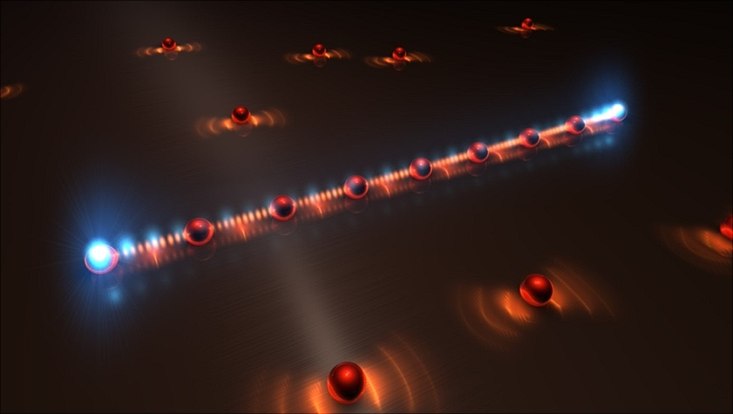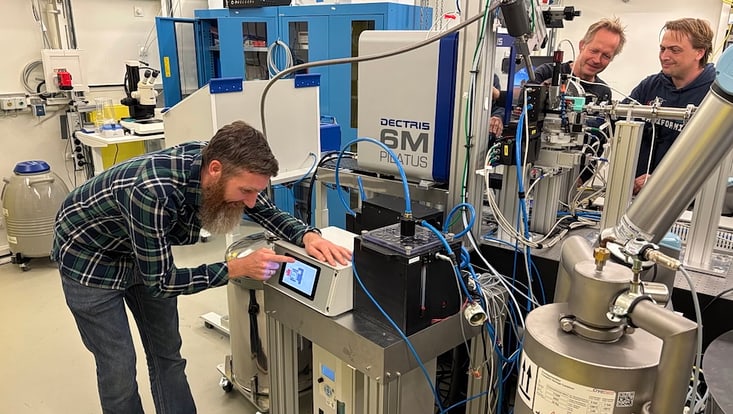Imaging of Matter
Topological bands by design
7 March 2022

Photo: UHH/MIN/Schneider
Linear magnetic chains on the surface of an elemental superconductor can host topologically non-trivial bands in their bulk and, as a result, the exotic Majorana modes on their ends. However, it is very challenging to tailor these bands and to design “on demand”. Scientists from the Department of Physics at Universität Hamburg have now demonstrated a way to do this using a bottom-up strategy. The study has been published in the journal Nature Nanotechnology.
Emergent Majorana modes (MMs) in condensed matter systems are of great interest to fundamental science because of their fascinating and exotic properties. But beyond that, Majorana-based devices are also expected to be among the leading candidates for next-generation qubits. MMs are predicted to appear at the boundaries of topologically non-trivial superconductors, for instance at the ends of one-dimensional magnetic chains in contact with a regular elemental superconductor. However, while several experimental works claim the observation of MMs, no fully conclusive proof of their existence has been given yet. In particular, scientists consider it important to find signatures of MMs together with a topologically non-trivial band structure in the bulk of the sample.
The optimal geometric structure for magnetic chains
Now, a team of physicists in the research group of Prof. Roland Wiesendanger at Universität Hamburg has presented a platform where topological bulk bands can be tailored almost at will. The scientist, who also conduct research in the Cluster of Excellence “CUI: Advanced Imaging of Matter”, have investigated single Manganese atoms adsorbed on an atomically clean superconducting Niobium surface. The magnetic moment of the adatoms locally induces electronic states within the gap of the superconductor, the so-called Yu-Shiba-Rusinov (YSR) states. When moving multiple adatoms close to each other, their individual YSR states couple and eventually form bands. “Interestingly, the YSR states are spatially anisotropic. Therefore, their coupling - and consequently the band formation in one-dimensional chains - depend on the crystallographic direction connecting the adatoms”, says Lucas Schneider, first author of the study and postdoc in the research group. “In this way, we found the optimal geometric structure for magnetic chains to develop a topologically non-trivial band structure.”
Spectroscopic signatures of end states consistent with MMs precursors
If the bulk of a chain is non-trivial, the bulk-boundary correspondence of topological matter predicts the presence of MMs at the ends of the magnetic chains. Indeed, the team has found spectroscopic signatures of end states which are consistent with the precursors of MMs, which are only limited by the finite length of the experimentally realized chains. For this reason, they show characteristic energy oscillations versus the chain length. Since these energy oscillations are always synchronized on both chain ends, the scientists rule out an interpretation of the end states by local disorder.
“These results will allow us to deepen our understanding of how topologically superconducting phases emerge in condensed matter systems – and they clearly set the stage for the next steps towards strongly protected Majorana states”, says Lucas Schneider.
Reference
L. Schneider, Ph. Beck, J. Neuhaus-Steinmetz, L. Rózsa, Th. Posske, J. Wiebe and R. Wiesendanger
"Precursors of Majorana modes and their length-dependent energy oscillations probed at both ends of atomic Shiba chains"
Nature Nanotechnology (2022)
DOI: 10.1038/s41565-022-01078-4
Further Information:
Prof. Dr. Prof. h.c. Dr. h.c. Roland Wiesendanger
Department of Physics
University of Hamburg
Jungiusstr. 9a
20355 Hamburg
Phone: 040 / 42838-5244
E-Mail: wiesendanger@physnet.uni-hamburg.de (wiesendanger"AT"physnet.uni-hamburg.de)


